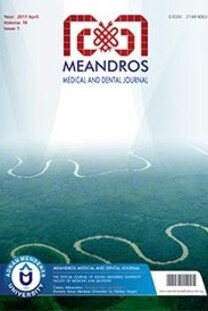Görünür Işık ve Ses Uyarılarının Göz Elektriksel Potansiyeli ve Oküler Kaslarda Oluşturduğu Etkilerin Elektrookülogram ve Elektromiyogram ile Değerlendirilmesi
Assessment of the Effects of Light and Sound Impulses on the Electrical Potential of the Eye and Ocular Muscles
___
- 1. Grossweiner LI. Photophysics the science of photobiology In: Smith KC, editor. Chapter 1, Plenum Press; 1989: 1-47.
- 2. Tuchin V. Optical properties of eye tissue. 3rd ed. Arizona: Tissue Optics SPIE Press: 2000: 109-29.
- 3. Plonsey R. Quantitative formulations of electrophysiological sources of potential fields in volume conductors. IEEE Trans Biomed Eng 1984; 31: 868-72.
- 4. Kolder H. EOG In Principles and practice of clinical electrophysiology of vision, Heckenlively JR, Arden GB, editors. 2nd ed. Chapter 39. Cambridge: The Mit Press; 1991: 301-13.
- 5. Nilsson SEG, Andersson BE. Corneal DC recording of slow ocular potential changes such as the ERG c-wave and the light peak in clinical work. Equipment and examples of results. Doc Ophthalmol 1988; 68: 313-25.
- 6. Röver J, Bach M. C-wave versus electrooculogram in diseases of the retinal pigment epithelium. Doc Ophthalmol 1987; 65: 385-91.
- 7. Matsuo F, Peters JF, Reilly EL. Electrical phenomena associated with movements of the eyelid. Electroenceph Clin Neurophysiol 1975; 38: 507-11.
- 8. Evinger C, Mannning KA, Sibony PA. Eyelid movements: mechanisms and normal data. Invest Ophthalmol Vis Sci 1991; 32: 387-400.
- 9. Gehricke JG, Oraitz EM, Siddarth P. Differentiating between reflex and spontaneous blinks using simultaneous recording of the orbicularis oculi electromyogram and the electro-oculogram in startle research. Intl J Psychophysiol 2002; 44: 261-8.
- 10. Kaneko K, Sakamoto K. Evaluation of three types of blinks with the use of electrooculogram and electromyogram. Percept Mot Skills 1999; 83: 1037-55.
- 11. Niida T, Mukuno K, Ishikawa S. Quantitative measurements of the upper lid movements. Jpn J Ophthalmol 1987; 31: 255-64.
- 12. Spencer RF, McNeer KW. The periphery: extraocular muscles and motor neurons. In: Cronly-Dillon J, editor. Vision and visual dysfunction. Chapter 8: Eye movements (Carpenter RHS, editor.), London: Macmillan Press; 1991: 175-99.
- 13. Fukaya C, Katayama Y, Kasai M, Kurihara J, Yamamoto T. Intraoperative electrooculographic monitoring for skull base surgery. Skull Base Surg 2000; 10: 11-5.
- 14. Schlake HP, Goldbrunner R, Siebert M, Behr R, Roosen K. Intraoperative electromyographic monitoring of extraocular motor nerves (Nn. III, IV) in skull base surgery. Acta Neurochir 2001; 143: 251-61.
- 15. Arden GB. Alterations in the standing potential of the eye associated with retinal disease. Trans Ophthalmol Soc U K 1962; 82: 63-72.
- 16. Bradley MM, Lang PJ. Affective reactions to acoustic stimuli. Psychophysiology 2000; 37: 204-15.
- ISSN: 2149-9063
- Yayın Aralığı: 4
- Başlangıç: 2000
- Yayıncı: Aydın Adnan Menderes Üniversitesi
The Effect of Different Chelating Agents on the Fracture Resistance of Endodontically Treated Teeth
Hicran DÖNMEZ ÖZKAN, Konul NAGHIYEVA, Pınar AÇKURT OKUTAN, Tuğrul ARSLAN
Situs İnversus Totalis Olgusunda Endoskopik Retrograd Kolanjiopankreatografi Uygulaması
Evaluation of the Anti-cancer and Biological Effects of Boric Acid on Colon Cancer Cell Line
Ayşe ÇİĞEL, Rauf Onur EK, Mehmet DİNÇER BİLGİN
Ayşe ÇİĞEL, Mehmet DİNÇER BİLGİN, Rauf Onur EK
Investigation of Alexithymia, Anxiety and Loneliness State in Bruxism Patients
Esra TALAY ÇEVLİK, Göknil ALKAN DEMETOĞLU, Rahşan ÇEVİK AKYIL, Musa ŞAMİL AKYIL
Ceasing Vitamin D Replacement in Infants with Premature Closure of Front Fontanelle: True or False?
Tolga ÜNÜVAR, Türkan UYGUR ŞAHİN, Erdal ADAL
Süveybe GÜNDOĞDU, NASİBE AYCAN YILMAZ
Kolon Kanseri Hücrelerinde Borik Asidin Anti-kanser ve Biyolojik Etkilerinin Değerlendirilmesi
Mehmet Dinçer BİLGİN, Ayşe ÇİĞEL, Rauf Onur EK
